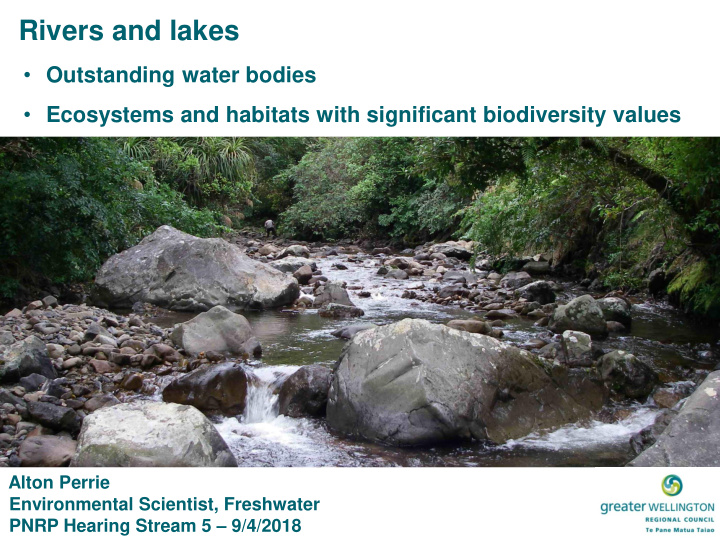



Rivers and lakes • Outstanding water bodies • Ecosystems and habitats with significant biodiversity values Alton Perrie Environmental Scientist, Freshwater PNRP Hearing Stream 5 – 9/4/2018
What is aquatic biodiversity in lakes & rivers?
Aquatic biodiversity - impacts • A wide range of factors can affect aquatic biodiversity including: – Water quality degradation – Water quantity/flow modification – Instream habitat degradation – Riparian/catchment habitat degradation – Habitat loss, fragmentation, disconnection, etc. – Introduced flora and fauna • Policy 31 sets out approach to minimise effects on aquatic biodiversity
Freshwater fish • Twenty indigenous fish – Mainly endemic – Many considered taonga • Small, cryptic and nocturnal • 16 are diadromous (migratory) – Seasonal spawning/migrations • 11 have threat ranking – 2 “Nationally Vulnerable” – 9 “At Risk” Evidence paragraphs 5.1 to 5.6
Fish distribution • Different species have different habitat preferences at both: – Large scales – Fine scales • Whole catchments are important • Mostly migratory species – Fish passage very important – Upstream and downstream Evidence paragraphs 5.1 to 5.6
Fish distribution – large spatial scales Upland species Lowland species
Fish distribution – fine spatial scales Fish distribution – Deep, slow flow species Shallow, fast flow species
Good fish habitat is not always obvious
Aquatic macroinvertebrates • Species range in sensitivity to water and habitat quality • Good relationship between macroinvertebrate community health and forest cover – High forest cover = good “health” – Low forest cover = bad “health”
Outstanding water bodies • Expert panel approach • Lakes criteria: – Aquatic vegetation values – Water Conservation Order • Outstanding lakes – Lake Wairarapa (WCO: Wildlife habitat) – Lake Kohangapiripiri – Lake Kohangatera
Outstanding water bodies • Expert panel approach • Rivers assessed against four criteria: – High macroinvertebrate health (MCI) with high indigenous forest cover (>80%) – Indigenous fish diversity (habitat for six or migratory indigenous fish species); and – Threatened fish species (habitat for nationally threated fish species); and – Large (5th order) rivers Evidence paragraphs 7.1 to 7.6
Outstanding water bodies • Outstanding rivers – Te Awa Kairangi (Hutt River) u/s of Kaitoke Dam – Otaki River u/s of and including Pukeatua River – Wainuiomata River u/s of Water Supply intake • Method M7 in PNRP recognises further development of outstanding criteria might be required Evidence paragraphs 7.1 to 7.6
Rivers and lakes with significant indigenous ecosystems • Four criteria originally developed and applied in 2009 to generate Table 16 of RPS • These criteria were established to meet overarching criteria of Policy 23 of RPS: – representativeness, rarity, diversity and ecological context • These four criteria were reapplied in 2014 for PNRP – Table 16 of RPS basically = Schedule F – Schedule F includes a few updates but no major changes • RPS has been subject to Schedule 1 process Evidence paragraphs 8.1 to 8.13
Rivers and lakes with significant indigenous ecosystems Four Criteria: • Rivers and streams with high macroinvertebrate health; • Rivers, streams and lakes that provide habitat for indigenous threatened/at risk fish species; • Rivers, streams and lakes that provide habitat for six or more migratory indigenous fish species; and • Rivers and streams that provide inanga spawning habitat. Evidence paragraphs 8.1 to 8.13
Rivers and streams with high macroinvertebrate health • Used a regional data set to develop thresholds between macroinvertebrate metrics and indigenous forest/scrub cover • Indigenous forest and scrub cover threshold applied to Region to identify sites • Different (lower) threshold used in Eastern Wairarapa Evidence paragraphs 8.1 to 8.13
Rivers, streams and lakes that provide habitat for indigenous threatened/at risk fish species • Used presence of selected threatened/at risk species from national rankings • Since 2009, the conservation status for many species have changed – Increasing from 30 to 55% of species – New conservation rankings were not included in the re-application of this criterion in 2014 Evidence paragraphs 5.5, 5.6 & 8.1 to 8.13
Rivers, streams and lakes that provide habitat for six or more migratory indigenous fish species • Used presence of six or more migratory species • Both criteria used NIWA’s National Freshwater Fish Database (NZFFD) to indicate presence – Best/only dataset available • Applied at catchment scale – Multiple species – different habitats – Diadromous (migratory) use whole catchment Evidence paragraphs 8.1 to 8.13
Rivers and streams that provide inanga spawning habitat • Identified based on spawning habitat assessments • Occurs in tidally influenced reaches – limited extent • Critical spawning period in autumn requires protection from disturbance
Significant rivers – regional extent • High macroinvertebrate health criterion identifies ~26% of Region • Two main fish criteria identify ~45% of Region • If you remove DOC and GWRC Parks from extent – Macroinvertebrate health ~11% of Region – Fish criteria ~29% of Region
Recommend
More recommend